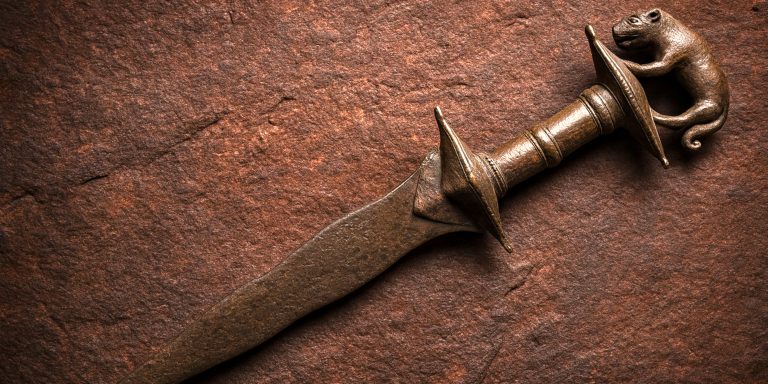
Attila the Hun remains one of the most formidable and controversial figures of late antiquity. As ruler of the Hunnic Empire from 434 to 453 AD, he forged a coalition of nomadic and subject peoples into a war machine that challenged both the Eastern and Western Roman Empires. To his enemies he was a destroyer, while among his own people he was a leader of unmatched authority.
Arms and Armour
The exact arms and armour used by Attila himself are unknown, as no confirmed personal belongings have survived. However, accounts and archaeological finds from the Hunnic period allow a reasonable reconstruction of the equipment typical of Hunnic leaders.
Hunnic warriors favoured composite bows made from wood, horn, and sinew, which provided a high draw weight and superior range. These bows were often carried in decorated gorytos that housed both bow and arrows. Attila’s warriors also used short swords or sabres, which were well suited to mounted combat. Spears and lances were common, often used in the opening stages of an attack before closing with bow fire.
Armour varied greatly, with many Huns relying on mobility rather than heavy protection. Elite warriors, including leaders, might have worn lamellar armour made from overlapping plates of iron or hardened leather, sometimes richly decorated. Helmets were often of segmented construction with cheek guards, a nasal bar, and occasionally gilt embellishments to signify rank.
Battles and Military Acumen
Attila’s reputation as a commander rested on his ability to coordinate large and ethnically diverse forces, using speed and surprise to overwhelm opponents. His campaigns showed a mastery of both mobility and intimidation.
In 447 AD, Attila launched a devastating campaign into the Balkans, defeating Roman forces and compelling the Eastern Roman Empire to pay increased tribute. Two years later he turned west, exploiting the political instability in Gaul. His forces sacked numerous cities before facing a combined Roman-Visigothic army at the Battle of the Catalaunian Plains in 451 AD. Although inconclusive, the battle halted Attila’s advance into Gaul and demonstrated his willingness to engage in set-piece battles when necessary.
In 452 AD, he invaded Italy, devastating cities such as Aquileia. The campaign was cut short, possibly due to famine, disease, or the need to respond to threats elsewhere in his empire. Throughout these campaigns, Attila’s use of diplomacy was as important as his military force, employing intimidation, strategic alliances, and shifting loyalties to maintain pressure on his enemies.
Where to See Artefacts from His Reign
Direct artefacts linked to Attila are rare, as the Huns were primarily a nomadic society and much of their material culture has not survived. However, items attributed to the broader Hunnic world can be found in major museum collections.
The Hungarian National Museum in Budapest holds weapons, horse gear, and decorative fittings from the period. The Hermitage Museum in St Petersburg also preserves fine examples of steppe nomad craftsmanship from the 4th to 5th centuries. The Kunsthistorisches Museum in Vienna displays gold jewellery and weapon fittings attributed to Hunnic or related steppe cultures. While none can be definitively tied to Attila, they provide valuable insight into the martial and decorative styles of his time.
Latest Archaeology Findings
Recent archaeological work across Central and Eastern Europe has improved our understanding of Hunnic settlement and movement patterns. Excavations in Hungary and Romania have uncovered elite burials containing gold harness fittings, weapons, and drinking vessels, suggesting that high-ranking Huns embraced both nomadic traditions and imported luxury goods.
Bioarchaeological analysis of skeletal remains has also shed light on Hunnic diet, health, and migration. Studies of cranial deformation, a cultural practice among Hunnic elites, confirm their distinct identity and status markers within a wider network of steppe peoples.
Although the location of Attila’s own burial remains unknown, continuing surveys in the Carpathian Basin may yet reveal clues. Historical sources describe a secretive burial in a triple coffin of gold, silver, and iron, hidden and protected to prevent desecration. No credible archaeological claim has confirmed this, but the mystery continues to fuel both scholarship and legend.
Watch the documentary:



